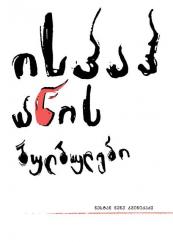The Nightingales of Isfahan is a post-modern text, a novelistic narrative written like a single-take film, a short story about all of Georgia: it tells us about the lives and fates of the generations. The novel’s main hero is an ornithologist Astamur who looks in various towns for the nightingales of Isfahan. Episodes from childhood form the novel’s Leitmotiv, so that we learn that the main hero has not been able to tell which of twin brothers is which: Parviz, who is said to have died, or Astamur, who is said to be alive. The novel is intersected by the loss of something, then making sense of it, valuing it, confessing to it and finally finding it (in reality, or on a mystic level). These are the complex and contradictory paths by which the main characters achieve self-awareness. The new generation is split up and divided. One half cannot see the necessity of poetry in the chaos of a war and a country recovering from war: it does not recognise fleeing the country as a priority. The other half has chosen as its profession the smashing of stereotypes, has sold its property and is taking away from the homeland the knowledge which they will further elsewhere: their flight instinct gives them no peace. Astamur represents the generation which has fled the country to various other lands, without looking back. They have found refuge in a parallel world, but remain hostages to the past. The couple who have emigrated to Amsterdam seem, at first sight, to have settled comfortably in a foreign land, where meetings with émigrés and sharing a foreign culture is an interesting process, without letting them abandon a native Leitmotiv, which comes sometimes from letters written by a friend, sometimes imbued through memories. The novel has love, it has dashed hopes, it has loss of faith, but the writer doesn’t depress her reader: she arouses her reader, who is tired and jaded by advertisements and superficial spectacles, to see beauty The death of the other main hero, Tata (who falls victim to an incurable illness in early youth) is portrayed without any heart-rending pathos, so that the reader perceives death as a beautiful continuation of life. In the novel, the pain of mortality is overcome by the joy of faith in immortality. The ‘Caucasian Alchemists’ knew the secret of life; Astamur, too, subconsciously senses a kinship with those distant ancestors. His constant ‘star-gazing’ is proof of this.The reason he does not marry Tata is that he is afraid of the mystery being ‘diluted’. The novel awakens many associations in the reader’s mind. With its ‘flow of consciousness’, using fragmentary and quasi-mythological symbols,
The Nightingales of Isfahan shows a tendency to becoming a neo-mythological novel. The story, narrated kaleidoscopically in two cities, is in fact a digest of Georgia’s recent past.
‘This book brings together Nesta Kvinikadze’s novels, tales and plays. But, although this collection tells us all kinds of different things and combines characters, atmospheres, tonalities, sounds and colours, the reader’s experience will always be that of one great, contrasting and often eccentric tragi-comic game played by the author. The stories in this book are sometimes unbearably realistic, sometimes, however, unexpectedly unreal.’
L. Bughadze, writer
EXTRACT
Translated into German by Tamar Rekk-Kotrikadse
Biologische Korridore
Ich saß auf dem einen Knie, mein Bruder auf dem anderen. Der Opa sang ein deutsches Lied, uns wurde angst und bange. Trotzdem mochten wir es gerne wild. Opa bewegte beim Singen die Beine. Der Höhepunkt des Spiels bestand darin, dass er ganz plötzlich etwas rief, die Augen schloss und heftig mit beiden Beinen aufstampfte, sodass wir im nächsten Moment auf den Boden purzelten. Aber schon gleich darauf stürmten wir erneut Opas Knie. Er machte große Augen und sah uns nacheinander an. „Ach!“ rief er. „Seid ihrschon wieder da? Welcher von beiden bist du denn?“ und das Ganze fing von vorne an.
„Zwillinge haben wir ja schon mal gesehen, aber so eine Ähnlichkeit noch nie!“ meinten alle, die uns begegneten. Angeblich konnte uns nicht mal unsere eigene Mutter unterscheiden.
Als einerder Zwillinge im Alter von vier Jahren tödlich verunglückte, wusste man nicht recht, welchen von beiden man beweinen sollte; das heißt, ich weiß bis heute nicht, wer ich bin – Farwis, von dem man sagt, er sei gestorben, oder Astamur, den man für lebend hält.
Jede Nacht fahre ich schweißgebadet aus demselben Traum hoch - dem Traum, in dem die Zwillinge auf Opas Knien sitzen und ihm mit ihren kleinen Händenabwechselnd die Augen zuhalten: „Opa! Rate mal, wer ich bin! Opa, kannst du uns sehen? Nicht gucken! Wer bin ich?“ Die Hände der Zwillinge werden feucht und schließlich begreifen sie, dass Opa weint… (See PDF)
In case of using the information, please, indicate the source.
